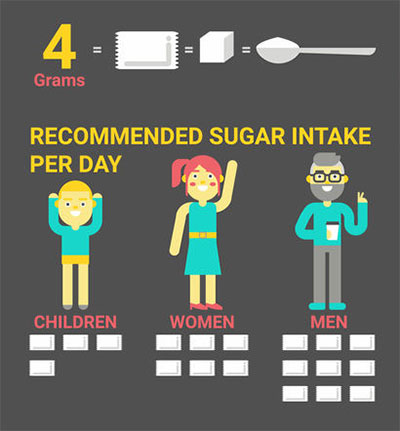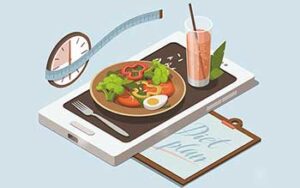We often hear that sugar is the enemy of weight loss and meeting your healthy living goals. Why is this and what can be done to help?
What are the negative effects of consuming too much added sugar?
Too much sugar can lead to a greater risk of tooth decay, type 2 diabetes and obesity. Obesity can increase the risk of all-cause mortality, high blood pressure, high cholesterol, coronary heart disease and many more health issues.
Why does too much sugar cause you to gain weight?
- Often high sugar foods contain lots of calories. As we know you will gain weight if you consume more calories than you use through your bodily functions and physical activity. Therefore an effective strategy to promote weight loss is to lower your calorie intake.
- Sugar is often referred to as an empty calorie, meaning that although high in calories there is little nutritional value in sugar.
- Products high in added sugar will be ‘used’ by the body quickly, therefore you will feel hungry sooner than if you had chosen a product lower in sugar and higher in fibre. Leading you to struggle to stick to your diet plan and weight loss goals.
What are the recommendations for how much sugar you should have per day?
The recommendations are based around added sugars. Added sugars are added to food such as cakes, biscuits etc and sugars naturally found in foods such as honey, syrups, smoothies and juices. Added sugars do not include the sugars that occur naturally in fruit, vegetables, milk and plain yoghurts.
Sugars should not make up more than 5% of your energy (calorie) intake.

- Adults – 30g or less of free sugars.
- Children aged 7-10 years old should have 24g or less of free sugars.
- Children aged 4-6 years old should have 19g or less of free sugars.
But what does 30g of sugar really look like?
- 2.5 tablespoons of sugar is around 30g.
- A portion of sugar-frosted corn-flakes contains around 11.5g of sugar. This means you would have already consumed 1/3rd of your daily sugar allowance in the first meal!
This full fat sugary drink contains 35g of sugar per can. This is 5g over the recommended daily amount per day.
The next time you eat a chocolate bar, read the nutrition label to see how many grams of sugar it contains.
Tips to reduce the sugar content in your diet and help you achieve your weight loss goals
- One of the easiest ways of lowering your sugar content is by implementing portion control. If you eat a healthy balanced diet, you will occasionally have dessert. Try having half the portion you normally would, small changes like this make the biggest difference.
- Be aware of what you are eating. Sometimes we don’t realise how much sugar we are consuming, tracking what you eat or following a healthy diet plan will help you reduce your sugar intake.
- Try to go for low sugar options although be conscious that they may be high in fat so always read the nutrition labels. This will also help with overall weight loss.
- Some take-away dishes are full of sugar and salt, for example sweet and sour dishes, avoid consuming these on a regular basis especially if you are trying to lose weight.
- Some products are advertised as healthy but are actually packed full of sugar, for example some breakfast cereals. Make sure you are aware of the sugar content of these products by checking the labels.
- Soft drinks are easy to consume everyday and in fact are frequently high in sugar, try low or no sugar alternatives or drink water where possible.
- It is also important to check the nutrition labels to see how much sugar is in a product. For example, fruit in syrup will contain more sugar than fruit in natural fruit juice.
In some recipes it is possible to reduce the sugar and not affect the stability of the product.
- In some recipes it is possible to reduce the sugar and not affect the stability of the product. This may require some experimentation to ensure you still enjoy the taste. You can try and replace some of the flavour by using extracts and spices. Jam, meringues and ice cream are examples of products where you cannot reduce the sugar content.
- Do not have a dessert after every meal. Instead, try slowly cut down so that a dessert is more of a treat.
- If you have sugar in tea and coffee slowly see if you can cut this down. If you are having multiple of these hot drinks per day the sugar can really add up.
Conclusion
Above are some great tips to reduce your sugar content. One of the most effective is to track what you eat, or follow a healthy diet plan and be aware of your sugar consumption. Knowing how much sugar is in your diet is especially helpful to help you lose weight and meet your healthy weight loss goals.
Studies discussed in the article
Sugar consumption, metabolic disease and obesity: The state of the controversy
Kimber L Stanhope
Link- https://pubmed.ncbi.nlm.nih.gov/26376619/



2 Comments
[…] these will be a good guide for adults, children have different requirements, for example less sugar, fat and salt. So make sure you are aware of your nutritional needs and roughly how much you should […]
[…] beans are higher in natural sugar so have a slightly sweeter taste. This can add great variety to the flavours of your meal and […]